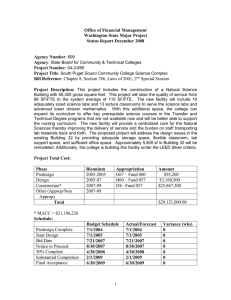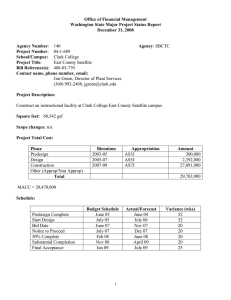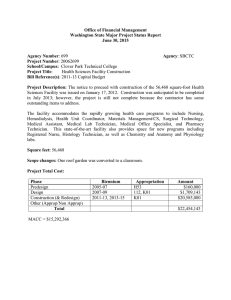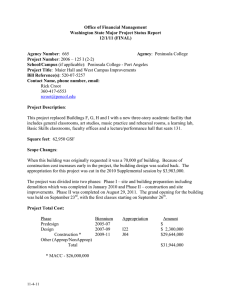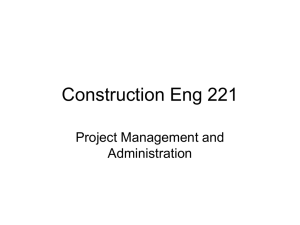Office of Financial Management Washington State Major Project Status Report June, 2015
advertisement
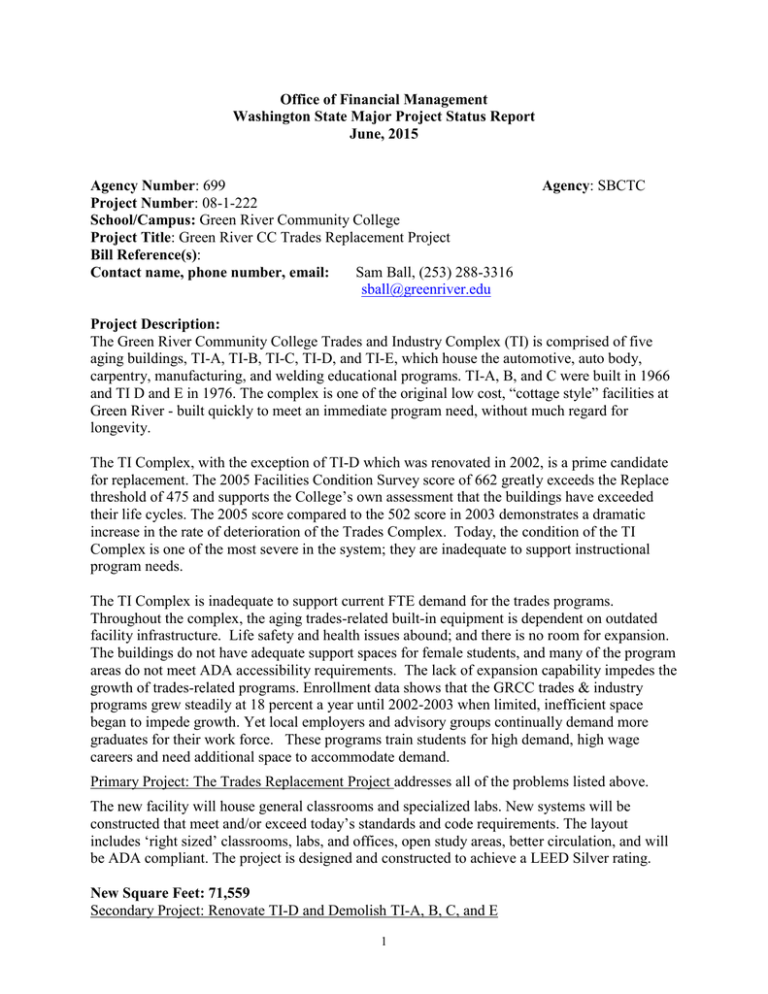
Office of Financial Management Washington State Major Project Status Report June, 2015 Agency Number: 699 Project Number: 08-1-222 School/Campus: Green River Community College Project Title: Green River CC Trades Replacement Project Bill Reference(s): Contact name, phone number, email: Sam Ball, (253) 288-3316 sball@greenriver.edu Agency: SBCTC Project Description: The Green River Community College Trades and Industry Complex (TI) is comprised of five aging buildings, TI-A, TI-B, TI-C, TI-D, and TI-E, which house the automotive, auto body, carpentry, manufacturing, and welding educational programs. TI-A, B, and C were built in 1966 and TI D and E in 1976. The complex is one of the original low cost, “cottage style” facilities at Green River - built quickly to meet an immediate program need, without much regard for longevity. The TI Complex, with the exception of TI-D which was renovated in 2002, is a prime candidate for replacement. The 2005 Facilities Condition Survey score of 662 greatly exceeds the Replace threshold of 475 and supports the College’s own assessment that the buildings have exceeded their life cycles. The 2005 score compared to the 502 score in 2003 demonstrates a dramatic increase in the rate of deterioration of the Trades Complex. Today, the condition of the TI Complex is one of the most severe in the system; they are inadequate to support instructional program needs. The TI Complex is inadequate to support current FTE demand for the trades programs. Throughout the complex, the aging trades-related built-in equipment is dependent on outdated facility infrastructure. Life safety and health issues abound; and there is no room for expansion. The buildings do not have adequate support spaces for female students, and many of the program areas do not meet ADA accessibility requirements. The lack of expansion capability impedes the growth of trades-related programs. Enrollment data shows that the GRCC trades & industry programs grew steadily at 18 percent a year until 2002-2003 when limited, inefficient space began to impede growth. Yet local employers and advisory groups continually demand more graduates for their work force. These programs train students for high demand, high wage careers and need additional space to accommodate demand. Primary Project: The Trades Replacement Project addresses all of the problems listed above. The new facility will house general classrooms and specialized labs. New systems will be constructed that meet and/or exceed today’s standards and code requirements. The layout includes ‘right sized’ classrooms, labs, and offices, open study areas, better circulation, and will be ADA compliant. The project is designed and constructed to achieve a LEED Silver rating. New Square Feet: 71,559 Secondary Project: Renovate TI-D and Demolish TI-A, B, C, and E 1 The TI-D HVAC and structural systems were replaced following the Nisqually earthquake and are currently in good condition. The College plans to move the campus shipping and receiving facility currently located in the Social Science (SS) building to TI-D prior to demolition of the SS building. TI-D is ideally located to serve shipping and receiving as it borders the main campus pedestrian corridor and is in close proximity to the campus’s main entryway. Renovated Square Feet: 7,282 Scope changes: The College negotiated the acquisition of 9 + acres of land across the street from the north side of the main campus. (See "Trades Replacement North Site" plan below) Transfer of ownership and land use processes were completed in December, 2011. The site is ideally suited for the construction of the Trades Replacement Project and removes some inherent challenges with the site identified in the pre-design. The severe economic downturn significantly reduced the funds available for state capital projects. This factor delayed the construction allocation for the Trades Replacement Project from the planned 2011-2013 to a future biennium. The college elected to complete the design process through Design Documents and mothball the project until the biennium targeted for construction funding is confirmed. The Appropriation History below reflects fulfilling design agreements through Design Documents only. Phase: Through DD Predesign Design Construction Total Through Mothball Biennium 2007-09 2009-11 TBD Appropriation I26 J08 TBD Amount $138,000 $1,707,000 $1,845,000 Project Status and discussion of Critical Path for Construction: In spring 2012, the SBCTC informed the college that a request for construction funding for the Trades project would be submitted to the 2013 legislature and the economic forecast indicated a strong likelihood that funding would be approved. They recommended that the college request approval to use local college funds to re-start the design process in anticipation of receiving construction funding in July, 2013. The Green River Board of Trustees and the SBCTC Board of Trustees approved the request to use up to $2,000,000 in local funds and the design process was re-started in summer 2012. In July, 2013, the Legislature allocated $26,774,000 for construction, a reduction of $3,855,000 from the original request. It was anticipated that local funds would be needed to backfill the reduction. The project was advertised for bids on September 10, 2013 and bids were opened on October 15, 2013. The apparent low bidder was nearly $1.5M over the estimate. All bids were rejected. 2 Non-instructional program value engineering options were considered and the project was re-bid in January, 2014 with bids opened February 6, 2014. The low bid became the new MACC and a new total project estimate determined the need for an addition of $4,000,000 in local funds to keep the project whole. The college and SBCTC boards approved a $4,000,000 request. The budgets and fund sources are outlined below Phase: Restart Project PreDesign Design Restart Design Primary Construction: Trades Primary Construction: Trades Total Trades Replacement Project Biennium 2007-2009 2009-2011 2012-2013 2013-2015 2013-2015 2013-2015 Appropriation I26 J08 Local Funds S00 Local Funds Amount $138,000 $1,707,000 $2,000,000 $26,774,000 $2,227,526 $32,846,526 Secondary: TID Renovation, Demo 2015-2017 Local Funds $1,772,093 Total Project $34,618,619 Primary MACC: $22,316,000 Secondary MACC: $779,160 Schedule: Start Predesign Start Design Re-Start Design Primary Project: Trades Bid Date (Bids rejected) Second Bid Date Notice to Proceed 50% Complete Substantial Completion Final Acceptance Secondary: TID, Demo Bid Date Notice to Proceed 50% Complete Substantial Completion Final Acceptance Budget Schedule 7/2007 7/2/2009 8/1/2012 10/15/2013 2/6/2014 3/15/2014 10/15/2014 6/29/2015 7/29/2015 TBD TBD TBD TBD TBD 3 Actual/Forecast 7/2007 7/2/2009 8/1/2012 Variance (wks) 0 0 0 10/15/2013 2/6/2014 4/3/2014 10/15/14 0 0 3 Behind 0 Contract Award History (Project when mothballed) A/E Agreement Construction Contract (excl. sales tax) Original Agreement $470,337 Bid Award Amount $0 Amendments $552,485 Change Orders $0 Pending Changes $0 Pending Changes $ ________ Total $1,022,822 Total $ Current Design Current Construction Contingency $0 Contingency $ Contract Award History (Project is Re-started): Primary Project: Trades Replacement A/E Agreement Construction Contract (excl. sales tax) Original Agreement $541,600 Bid Award Amount $22,316,000 Amendments $1,753,556 Change Orders $1,568,185 Pending Changes $0 Pending Changes $ 0 ________ Total $2,295,156 Total $23,884,185 Current Design Current Construction Contingency $0 Contingency $726,439 Contract Award History: Secondary Project TID Renovation, TIA, B, C, E Demolition A/E Agreement Construction Contract (excl. sales tax) Original Agreement $ Bid Award Amount $ Amendments $27,747 Change Orders $ Pending Changes $ Pending Changes $ ________ Total $27,747 Total $ Current Design Current Construction Contingency $ Contingency $ Potential for Project Cost Overruns/Claims No overruns or claims have occurred. Discussion of Project Quality The Trades replacement project is both a product of the campus master planning process and a key element in implementing the master planning. It is being designed using campus building standards, county codes and regulatory requirements, along with current sustainable design and energy standards. A systematic faculty, staff, and design team approach will assure that critical programmatic needs of the college are met. Project Photographs: see photos below 4 Entrance to Automotive Shop 5 Automotive Shop 6 Entrances to Welding, Manufacturing Shops 7
